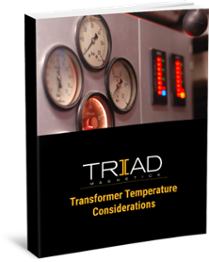All electrical devices produce heat as an operational byproduct. In transformers, normal operation causes an internal temperature increase or temperature rise. When the transformer is at its nameplate rating, the transformer temperature rise is the average temperature increase of the windings above the ambient temperature. This increase in temperature has the potential to shorten the transformer’s lifespan.
As a result, proper insulation is critical. Many transformer failures are caused by a breakdown of their insulation systems. Moisture, overloading, and extreme temperatures can all affect the insulating properties inside a transformer and thus reduce its lifespan. This blog post will go into further detail about transformer temperature rise and why transformer insulation system ratings are important.
Temperature Rise and Transformer Efficiency
.jpg?width=224&name=thermal%20transformer%20image%202%20(2).jpg) Temperature rise involves both how much heat is generated and how much is removed. It is possible for a transformer to feature low heat generation, but because it does not effectively remove that heat, the unit lacks overall efficiency. Obtaining the actual load and no-load losses in watts from the product manufacturer is the best way to understand a transformer’s true efficiency.
Temperature rise involves both how much heat is generated and how much is removed. It is possible for a transformer to feature low heat generation, but because it does not effectively remove that heat, the unit lacks overall efficiency. Obtaining the actual load and no-load losses in watts from the product manufacturer is the best way to understand a transformer’s true efficiency.
When this information is not available, however, temperature rise alone can function as a rough indicator of a transformer’s efficiency. In general, the most efficient transformers create minimal heat waste and result in lower temperature rises, while less efficient transformers generate more heat waste and have higher temperature rises. Efficient transformers have longer life expectancies.
Why Are Transformer Insulation System Ratings Important?
Since temperature rise impacts a transformer’s life, adequate insulation systems are essential. A transformer’s insulation system rating is the maximum permitted operating temperature of a transformer for it to have a normal lifespan. Ratings are typically based on a maximum ambient temperature of 40 °C.
The insulation rating is categorized by temperature rating and deduced from the total sum of the temperature rise, hotspot allowance, ambient temperature, and safety margin. Ratings also help define a transformer’s overload capability. This chart summarizes the most common insulation ratings:
|
UL1446 System Class |
Maximum Hot-Spot Temperature Rise |
||
|
United States |
Canada |
°C |
°F |
|
105(A) |
A |
105 |
221 |
|
120(E) |
- |
120 |
248 |
|
130(B) |
B |
130 |
266 |
|
155(F) |
F |
155 |
311 |
|
180(H) |
H |
180 |
356 |
|
200(N) |
C |
200 |
392 |
|
220(R) |
C |
220 |
428 |
|
240(S) |
C |
240 |
464 |
-
Class 105: Insulation class A features an average winding temperature rise of 55 °C, hot spot temperature rise of 65 °C, and maximum winding temperature of 105 °C.
-
Class 130 or 150: Insulation class B features an average winding temperature rise of 80 °C, hot spot temperature rise of 110 °C, and maximum winding temperature of 150 °C.
-
Class 180: Insulation class F features an average winding temperature rise of 115 °C, hot spot temperature rise of 145 °C, and maximum winding temperature of 180 °C.
-
Class 200: Insulation class N features an average winding temperature rise of 130 °C, hot spot temperature rise of 160 °C, and maximum winding temperature of 200 °C.
-
Class 220: Insulation class H features an average winding temperature rise of 150 °C, hot spot temperature rise of 180 °C, and maximum winding temperature of 220 °C.
Transformers From Triad Magnetics
The temperature rise and insulation system rating of a transformer are important factors to consider when selecting a product that will meet the appropriate efficiency standards and lifespan of a given application. At Triad Magnetics, we have over 75 years of experience developing magnetic technology solutions that exceed our customers’ expectations. Our experts can help you find the best transformer for your application. Learn more by contacting us today or downloading our eBook, Transformer Temperature Considerations.








